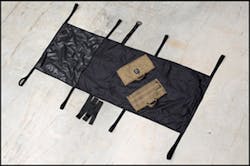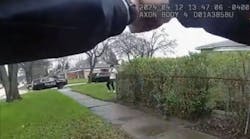I'd be the first to admit that I'm not a combat medic, tactical medic or any other kind of "medic". I'm one of those people who has had my share of basic first-aid as well as advanced first-aid and the bits and pieces of trauma wound treatment one picks up from true tactical medics. Most of the downed officer/soldier extraction I've been trained to deal with involves a drag handle and moving fast under the cover of suppressive fire or behind a hard vehicle. So when I got to test and use the Phantom Litter from Tactical Medical Solutions I had to expand my mind and knowledge base.
Obviously in "under fire" extractions then little consideration is given beyond getting the downed officer / soldier out of the line of fire. Grabbing a drag handle and pulling as hard and fast as you can while your partners and team-mates provide cover fire is the rule of order. Grab-n-Go as fast as you can while staying as low as possible. But what about when the battle is over and you need to get a downed team mate from Point A to the nearest ambulance and the conditions are such that you can't get the gurney to Point A? Then a stable means of carrying said team mate is required. Enter the Phantom Litter from Tactical Medical Solutions.
Weighing less than a pound (not including the pouch pocket shown) the Phantom Litter is an easily carried option that provides an evacuation platform specifically designed for team medics, officers or soldiers. What caught my attention most about this particular litter and the way it's carried is how it was specifically designed to be integrated into the operator's already carried equipment. With the large majority of operators today wearing a MOLLE-system modular vest built to their own needs and specifications it only makes sense to have the carry system for the litter incorporate into that - preferably in a manner than enhances it if possible, but certainly that doesn't retract from it in any way.
With MOLLE webbing on both sides, the Phantom Litter pouch was designed to be put behind other pouches, accessible from the bottom (as shown). Because of the webbing on both sides, whatever pouches you'd normally mount on that rack on your vest is simply mounted on top of the litter's pouch. In some instances this has the positive side effect of moving your magazines slightly away from the vest surface making it easier to grab them in a hurry.
Additionally, the litter is designed to be used as more than just a litter. Once the casualty has been moved to a more suitable location and transfered over to a gurney, then the litter can be used as an equipment bag to hold all of the casualties kit. I liked that idea since I've seen officers treated roadside and when everyone cleared the scene there was inevitably something left behind. I can only imagine that it's even worse in true combat zones where the downed soldier or operator is carrying MUCH more kit, therefore potentially leaving a lot more behind.
The raw data:
- Packed Dimensions: 12" x 7" x 1.5"
- Litter Dimensions: 65" x 23" (NOTE: that's about 5.5 feet. Longer would be good, but obviously takes more space to pack and store)
- Weight: 15 ounces (internal mount) / 19 ounces (external mount)
- Weight capacity: 450 pounds
- Grab points: 8
- 1.5" nylon securing strap nylon webbing with friction buckle
Now, before I go on, let me assure you of one thing: when you and one other person attempt to test or use this litter with a "casualty" who weighs in excess of 300 pounds without his gear, it's not easy! But that's what we did in testing (real smart, eh?) The published material from Tactical Medical Solutions says they tested the Phantom Litter with a 500 pound load for 24 hours. They rate it at 450 pounds. We moved a 315 pound man plus all his kit (about another 30 pounds) two hundred yards. Nothing broke or tore (except maybe some muscles in my back).
Extracting the litter from the pouch and folding it open is quick and easy. I'd seriously recommend you do that a couple times before you need to do it "under fire". Why? Because you need to learn how to fold it properly to put it back. Getting it out is easy. Getting it back in is more like putting together a slightly challenging puzzle, but doesn't it always work that way?
I started to say that, minimally, this would be a good tool for team medics, but given the rash of mass casualty incidents we've seen lately (from Virginia Tech to Ft. Hood to... well, pick a spot you've seen in the news) it might be wise for multiple team members to have these available. At about one pound in weight and not sacrificing pouch mounting space, I don't see a real downside. Budget is always a concern but these are less than $100 a piece (on the TacMed website). Getting five for your team isn't such a huge budgetary issue when you take that into consideration.
Valuable, compact and, in some cases, indespensible for use. Check it out. It may be exactly what you're looking for.
Stay Safe!



